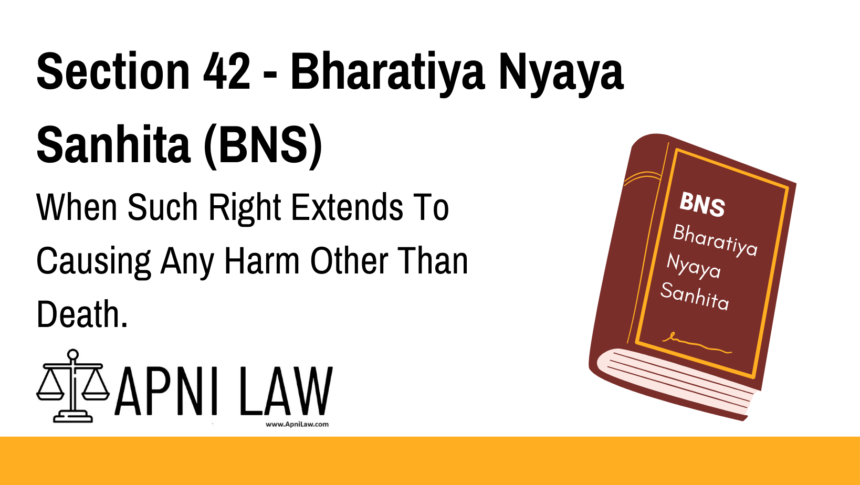Code: Section 42 BNS
If the offence, the committing of which, or the attempting to commit which occasions
the exercise of the right of private defence, be theft, mischief, or criminal trespass, not of any
of the descriptions specified in section 41, that right does not extend to the voluntary
causing of death, but does extend, subject to the restrictions specified in section 37, to the
voluntary causing to the wrong-doer of any harm other than death.
Explanation of Section 42 BNS
Section 42 of the Bharatiya Nyaya Sanhita (BNS) defines the extent to which a person can exercise their right of private defense. This provision clarifies that an individual may cause harm (short of death) while defending themselves or others, provided the circumstances do not justify the extreme measure of causing death (as outlined in Section 41 BNS).
Key Takeaways:
- No Right to Cause Death: Unlike Section 41, this provision explicitly states that one cannot voluntarily cause death under private defense unless covered under Section 41.
- Permissible Harm: While death is not allowed as a defensive measure, any other form of harm (such as injury or restraint) may be inflicted in self-defense.
- Proportionality: The force used must be proportionate to the threat faced, meaning unnecessary or excessive violence is not justified.
Illustrations
Example 1: Self-Defense Against an Unarmed Attacker
A man is suddenly attacked by another individual using only fists. In response, he punches the attacker back and pushes him to the ground to stop the attack.
✅ Allowed under Section 42 – The defender caused harm (without causing death) to protect himself.
Example 2: Defense Against a Thief
A shopkeeper catches a thief trying to steal cash from the counter. The thief does not have a weapon. The shopkeeper grabs a stick and hits the thief’s legs to stop him from escaping.
✅ Allowed under Section 42 – The harm caused was justified to prevent the theft and secure the offender.
Example 3: Excessive Force Not Justified
An argument escalates into a fight. One person slaps the other, and in retaliation, the victim pulls out a knife and stabs the attacker.
❌ Not Allowed Under Section 42 – The use of a knife was disproportionate to the harm received and does not qualify as justifiable private defense.
Common Questions & Answers on Section 42 BNS
1. Can I kill someone in self-defense under Section 42 BNS?
No. Section 42 only allows causing harm (other than death) in private defense situations. However, Section 41 BNS lists specific conditions where causing death is justifiable.
2. What kind of harm is allowed under Section 42?
Any harm short of death, such as injuries, restraint, or using force to neutralize an attack. However, the harm must be proportionate to the danger faced.
3. What happens if I use excessive force beyond what is permitted?
Using excessive force beyond the necessity of self-defense can lead to criminal liability. The court will assess whether the force used was reasonable.
4. Can I injure a thief trying to escape?
Yes, as long as the harm is proportionate and necessary to stop the theft. You cannot use deadly force unless the thief poses a direct life-threatening danger.
5. Is verbal abuse or threats enough to justify private defense under Section 42?
No. Mere verbal abuse or threats without physical aggression do not justify causing harm under Section 42 BNS. There must be an actual attack or imminent threat of harm.
Conclusion
Section 42 of BNS ensures that individuals have the right to protect themselves from harm while maintaining a proportionate use of force. It strikes a balance between self-defense and legal accountability, preventing unnecessary violence.
For expert legal insights, visit ApniLaw today! 🚀








